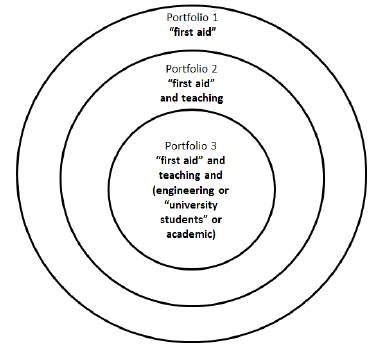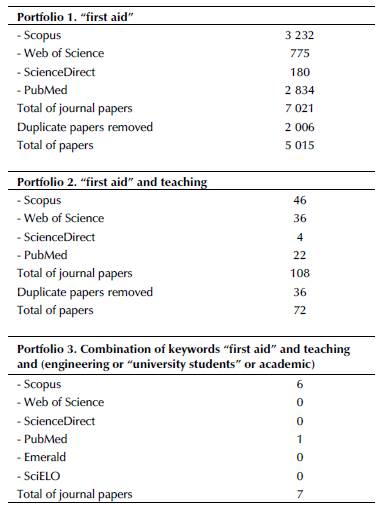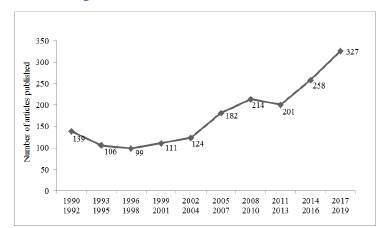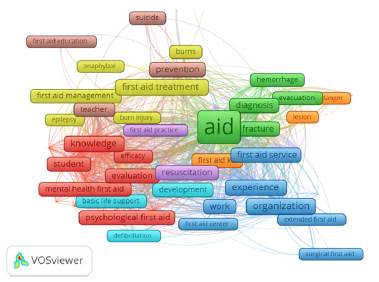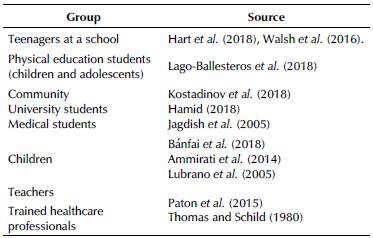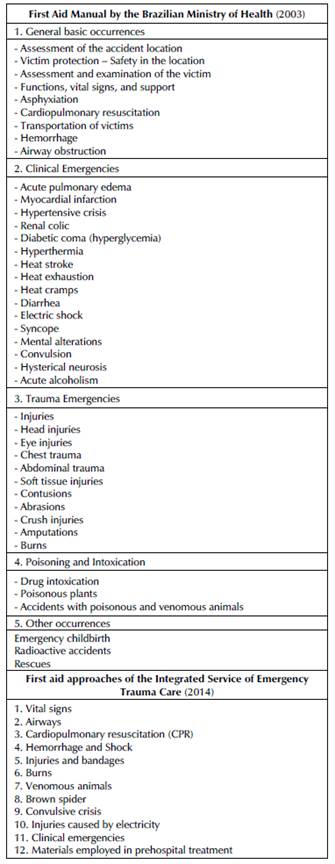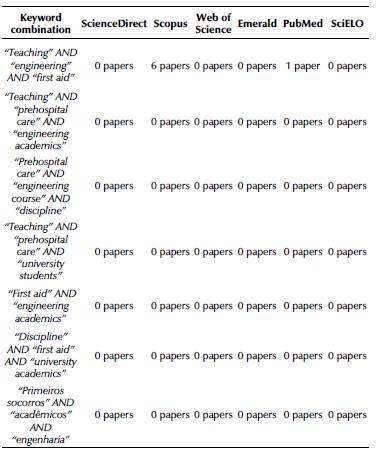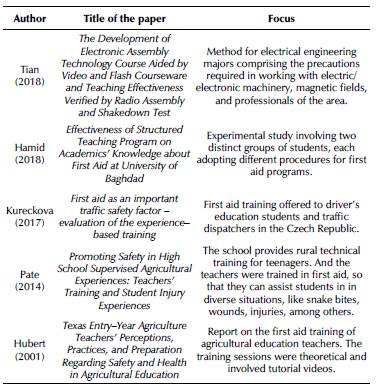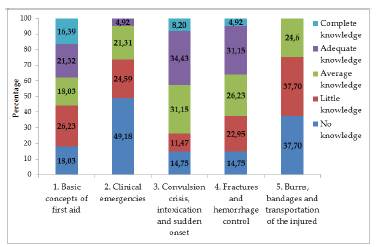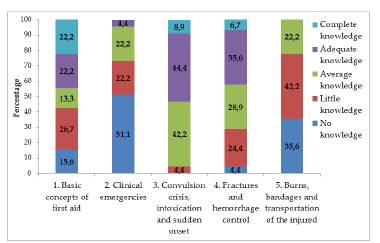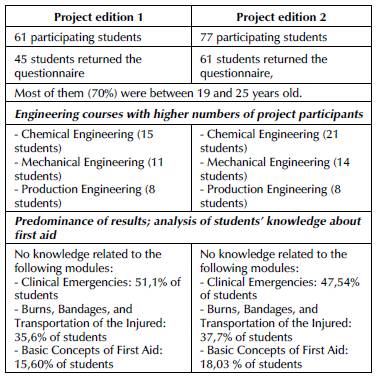Introduction
The significant increase in world population, technological innovations, and the expansion of economic and industrial growth, in addition to the aspect of urban violence and environmental conditions, are the main causes of accidents. Since self-care actions cannot be fully applied to protect against the risks of daily living, they do not depend solely on individuals, but also on their context (Veronese and Oliveira, 2006).
Regardless of the danger, it has become necessary to identify hazards whenever possible and manage them accordingly. Therefore, preventive actions are essential, followed by corrective actions, in order to minimize impacts and damages to humans or administer the necessary care as a person, citizen, worker, or user (Bail et al., 2019). Day to day, thousands of people go through medical emergencies experiencing and/or witnessing adversities. In these moments, spectators usually provide spontaneous aid (Velde et al., 2006).
First aid is a knowledge science that is part of the greater area of health and safety at work (Veronese and Oliveira, 2006). It is of extreme importance, as it makes it possible to save lives, seeing that people are increasingly exposed to dangers and risks of different types and intensities in their commute from a place to another, in their work environment, at the university, among others (Bail et al., 2019). Danger can be defined as a potential threat to one's physical and psychic integrity and welfare, whereas hazard is the probability of adversities or accidents (Velde et al., 2006). Risk arises not only from how the future can be described, but from the uncertainty surrounding that description (Eiser et al., 2012).
First aid comprises assistance offered in cases involving accidents, search and rescue, removal of victims from dangerous locations, requests for help, infection control, bleeding, injuries, spine and head trauma, musculoskeletal trauma, oral poisoning, and other needs (Velde et al., 2006). It basically involves emergency care or procedures applied before medical treatment (Cuttle et al., 2009).
First aid teaching, training, and approaches are essential to prepare people for adversities (Velde et al., 2006). In order to reach everyone, researchers and experts recommend approaching first aid in schools (Engeland et al., 2002) and universities to reduce untimely deaths caused by accidents and other adversities (Khan et al., 2010). The more people are prepared for providing first aid, the safer the environment becomes for everyone.
In developed countries, the knowledge about first aid practices has been introduced to not only healthcare professionals, but also to basic education for children at schools, thus shaping citizens who are aware of how to act in case of emergency (Azhar and Choudhry, 2016). One of reasons for this is the high incidence of natural disasters, even though they are not the only causes of accidents and damage to human beings.
On the other hand, in developing countries such as Brazil, this type of training is limited to healthcare professionals in specific aid and rescue organizations or in companies via basic tutorials. It is necessary to transfer knowledge, both to healthcare staff and the general public, bearing in mind that the United Nations (UN) determines that ensuring the community's health, safety, and welfare, especially through prevention, is mandatory (Leiva et al., 2014).
The aim of this paper is to present the results of a bibliometric analysis regarding first aid, as well as a case report on teaching in first aid involving a group of undergraduate students. The case report presents a project developed at a Brazilian public university for engineering students. Unlike degree programs in the field of health such as nursing and medicine, engineering degrees do not feature first aid approaches, which entails a deficiency for students regarding this knowledge, seeing as Brazilian schools do not approach first aid teaching for children and teenagers either.
With this goal, this paper aims to answer the following questions:
In the international scope, are there reports of studies about first aid teaching in engineering degrees?
Are engineering undergraduate students knowledgeable about first aid?
How can this knowledge be specifically transferred to engineering students?
The university where the study was conducted offers a greater number of undergraduate programs in this field, such as mechanical, electrical, chemical, computer, and production engineering. For this reason, the first aid case report focuses on engineering courses. It is the result of an extension project developed at the Federal Technological University of Paraná, Ponta Grossa, Brazil.
As emphasized, first aid teaching is important for individuals and professionals, not limited to undergraduate health courses, as is the case in Brazil. Through this project, we have expanded the teaching to engineering students.
Methodology
Initially, a systematic literature review was conducted, which was based on the structured protocols by Pagani et al. (2015) called Methodi ordinatio. This method is a multi-criteria decision aid tool, which allows researchers to ponder using three variables: impact factor, number of citations, and year of publication. The pondering on these variables generates an index, the InOrdinatio, which indicates the scientific relevance of the paper. From this index, it is possible to rank the papers individually (Pagani et al., 2015; Silva et al., 2020). Studies that applied the Methodi ordinatio include Pagani et al. (2019), Bail (2019), Bail et al. (2020), Soares et al. (2020), Moura et al. (2020), Silva et al. (2021), and Corsi et al. (2021), among others.
Figure 1 illustrates the three paper portfolios defined, each with a more specific purpose.
Portfolio 1 was created for the bibliometric analysis of papers by consulting four international databases (Scopus, Web of Science, ScienceDirect, and PubMed). Systematic research works from a qualitative perspective, as it analyzes the alignment of articles with the focus of the research objective. However, in the context of the research, there is also a quantitative point of view that is related to bibliometric study (Chiroli et al., 2016). The basic filtering criteria employed in each database comprised a keyword inserted in titles, a time period including all years, and the type of document (such as journal papers). The search on the databases was conducted in January 2020, so only data from 2019 and previous years were included, with no other restrictions. The papers were exported in the bibtex format to the Mendeley reference manager software, eliminating all duplicate results.
The bibliometric analysis explored data related to the papers about first aid, defining the years of publication, the central journals in the field considering the number of publications, and the terms most employed in the papers.
Portfolio 2 aimed to find papers for reading in full, both to better understand the studies about first aid teaching in the international scope and to prioritize the relevant subjects in the discussion. This portfolio employed a combination of keywords, "first aid" and "teaching", also inserted in titles, followed by the aforementioned basic filtering criteria. After discarding duplicate papers, the Methodi ordinatio was applied. It is a tool that sorts scientific papers based on impact factor, year of publication, and number of citations, and it is managed by Equation (1):
where IF is the impact factor, α is a weighting factor ranging from 1 to 10 to be attributed by the researcher; ResearchYear is the year in which the bibliographic research was developed; PublishYear is the year in which the selected paper was published; and Ci is the number of times the paper has been cited on Google Scholar (Pagani et al., 2015).
In this way, the articles with the highest InOrdinatio values of the Methodi ordinatio were selected.
Portfolio 3 sought to explore, in the literature, the existence, formalization, and further approaches of first aid teaching in engineering degrees. This portfolio is directly aligned with a case report in this study, focusing on the teaching and knowledge transfer to a specific group of students. Unlike the other portfolios, the keywords were inserted in the papers' titles, abstracts, or keywords, and six databases were consulted (Scopus, Web of Science, ScienceDirect, PubMed, Emerald, and SciELO). The papers were exported to Mendeley, eliminating duplicates, and then read in full.
After the systematic literature review (bibliometric and content analysis of the papers), an extension project developed at a Brazilian public university was described.
The project, called SOS - UTFPR, was created in August 2017 at the Federal Technological University of Paraná. As of today, the course encompasses theoretical (lectures, simulations, and classroom seminars) and practical classes (monthly training sessions, emergency drills, and technical visits to local companies). The project established partnerships between the university, companies, and public organizations such as the fire brigade, focusing on the Mutual Assistance Plan (PAM) and obeying international standards, according to the World Protocol of Prehospital Care of the American College of Surgeons' Committee on Trauma (PHTLS) and the American Heart Association (AHA).
The case report on project SOS explores data and information such as the knowledge level of engineering students, the modules included in the project, relevant subjects that are inherent to first aid, and how they are significant for those students, as well as the Brazilian context of first aid teaching and other aspects. The students involved in the case report are participants in the project. They carried out their registrations according to interests on the subject. Therefore, no sampling selection was carried out, as all enrollees were automatically incorporated into the project.
Results and discussion
The numbers of articles entered in each portfolio are presented in Table 1.
Bibliometric analysis: Portfolio 1
A total of 5 015 journal articles was analyzed, which have direct foci in first aid. Their publication over the years is shown in Figure 2.
The period between 2017 and 2019 presented the largest number of articles published in journals: 327 articles, succeeding 2014-2016 with 258 articles, and 2008-2010 with 214 articles. In an interrupted period from 1927-1989, another 3 216 were indexed in the consulted databases, in addition to years prior to 1927, with records of 38 articles.
The main journals, according to the quantities of published articles on first aid, are listed in Table 2.
Table 2 Main journals of articles on first aid in general
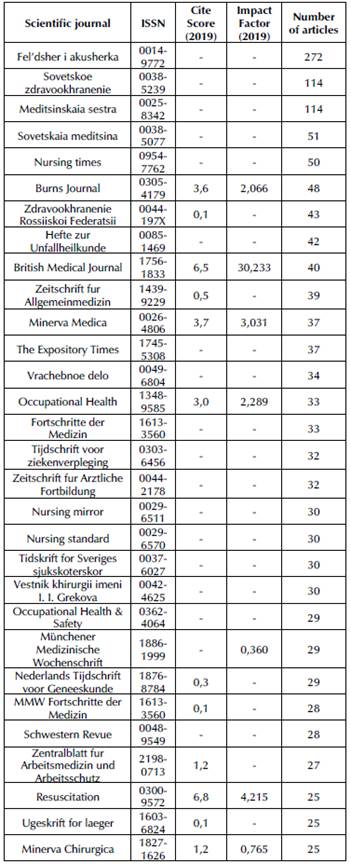
Source: Data collected from Scopus, PubMed, Web of Science, and ScienceDirect
The most frequent terms inserted in the portfolio with 5 015 articles are presented in Figure 3.
Analysis of articles: Portfolios 1 and 2
Velde et al. (2006) define first aid as a set of fundamental practices to apply efforts and provide aid until professionals (e.g., doctors) are available for specialized services. According to the authors, it is the immediate assistance given to a sick or injured person, comprising procedures and techniques that require little to no equipment. A first aid provider must be able to assess the situation as fast, albeit adequately, as possible, deal with life-threatening conditions, and contact medical assistance (Abbas et al., 2011).
Lack of knowledge or inadequate training may result in inefficient or even harmful interventions (Velde et al., 2006). In case of adversities, delays in the treatment may entail severe consequences for the patient, so proper knowledge in first aid is useful (Ertl and Christ, 2007).
First aid courses are not limited to the treatment of physical injuries; they also include emotional support and dealing with stress and collective and individual anxiety (Velde et al., 2006). Teaching and learning in first aid are established through lectures, demonstrations, theoretical and practical classes (experiments or drills with dummies or candidates), videos, and formal materials elaborated by experts and competent institutions (Das and Elzubeir, 2009).
Thus, first aid applications seek to reduce suffering, stop the clinical condition of the patient from worsening, prevent deaths, relieve pain, minimize physical and mental damage, and reduce edemas (Cuttle et al., 2009).
The topic of first aid is full of theoretical and practical approaches useful for instructing various audiences, some of which are listed in Table 3.
Some studies have focused on more specific approaches to first aid, highlighting mental health first aid (Hart et al., 2018), drug and alcohol first aid (Allan et al., 2016; Kostadinov et al., 2018), hypothermia and evaluation of clinical symptoms (Pysny et al., 2015), domestic accidents (Ergenekon, 2012), among others.
To provide knowledge about first aid in general, some modules have been proposed by government institutions. Table 4 describes the modules regulated and addressed by Brazilian institutions.
In addition to the first aid approaches presented in Table 4, the Brazilian Mobile Emergency Care Service (2002) provides detailed actions and instructions for first aid and prehospital treatment. Their material is in-depth and complete, especially concerning basic occurrences in first aid.
In order to determine whether undergraduate engineering students have knowledge about first aid, a new search was conducted, exploring six different databases. It sought to ascertain whether there were studies related to this matter, but it found that no papers focused on the permanent and continuous teaching of first aid; instead, there were only brief talks on the subject. Table 5 presents the total of papers found via each keyword combination.
Studies on the teaching of first aid and prehospital care in engineering courses, or in higher education at large, are lacking except in fields related to human health, according to the paper analysis (Table 6).
The studies above are lacking in certain aspects. The target public of the instruction was the faculty rather than the students, and the techniques employed were shallow and simple. Moreover, they lacked practical lessons, limiting themselves to tutorial videos and lectures.
Education is a strong tool in the systematic construction and promotion of knowledge and skills in all fields, as well as in creating desired attitudes towards issues of occupational safety and health (OSH), including the environment, the safety of technical equipment, the optimization of working conditions, and first aid (Bail et al., 2019; Chiroli et al., 2019; Kozik and Bulla, 2013).
Considering that engineering is a necessary industry to maintain current social standards, maintain infrastructure and advance innovations, knowledge and preparation for first aid situations is important and necessary. Engineers work in a variety of environments where professionals are under different types of pressure (industrial, technical, political, economic, environmental, and financial), which poses many risks.
Knowledge and practices in first aid are necessary for all types of professionals, and, for engineers who work in leadership, this knowledge favors more effective actions. It is important to highlight that, when first aid actions are performed on an accident victim, the worsening of the clinical condition is avoided, and a life can be saved.
Therefore, training professionals on the notions of first aid becomes essential in the work environment and is never in vain, as it is not only at work that this knowledge can be useful; there are risks everywhere, and accidents can occur unexpectedly, regardless of time or place. Therefore, it is always good to be prepared and help save lives (Pergola and Araujo 2008; de Sousa, 2018; Rosa et al., 2001).
In the next subsection, the results of a project developed in a Brazilian public university about teaching first aid practices will be presented.
Case report: first aid project in engineering
Project SOS from UTFPR, Brazil, is an extension mode that comprises 124 hours of theoretical and practical classes about first aid. The project's goal is to provide engineering students with theoretical and practical knowledge about the main first aid techniques, such as acting in emergencies and adversities, the crucial attitudes to be taken, and other basic pertinent matters until the arrival of medical professionals or health experts. After its planning and didactic-pedagogical structuring, the project began and was announced through the institution's social networks. To enroll, the students were required to fill out a questionnaire with basic information (name, age, and academic degree), as well as their level of knowledge about first aid through questions centered on the topic. The questionnaire consisted of a mechanism to understand the participants' profiles.
The project has no limit for enrollments. Although it was an unprecedented project in Brazil, students enrolled according to their level of interest in the subject.
In the first edition, from August 2017 to July 2018, a total of 61 students enrolled in the project. Most of the students (70%) were between 19 and 25 years old, followed by freshmen aged 18 or younger (21,70%). Only 8,30% of the students were over 25 years old.
Out of 61 enrolled students, 45 answered the questionnaire and applied before the project started. It contained ten basic questions regarding the central modules of first aid, with the purpose of assessing the knowledge level of the participants in terms of the course modules, which are presented in Figure 4.
In the second edition, from August 2018 to July 2019, a total of 77 students enrolled in SOS - UTFPR. Most of them (70%) were between 19 and 25 years old.
Out of the 77 enrolled students, 61 answered the questionnaires and applied before the project started. It contained ten basic questions regarding the central modules of first aid, with the purpose of assessing the knowledge level of the participants (Figure 5).
Figures 4 and 5 show that the initial assessment sought to ascertain the students' intrinsic knowledge about the subject, judging whether their answers adequately met the guidelines of the world protocol of prehospital care (PHTLS). The questionnaire also found that the students had the least knowledge about the modules involving clinical emergencies and burns, bandages, and transportation.
In addition to engineering courses, the project included two other UTFPR courses: biology and natural sciences; as well as the technological courses. Therefore, all courses available at the Ponta Grossa, Brazil, campus of UTFPR participated in the SOS project. This included the following programs: Chemical Engineering (15 and 21 students, in the first and second edition, respectively); Mechanical Engineering (11 and 14 students); Production Engineering (8 students in both editions); Electronic Engineering (8 students in both editions); Biotechnology Engineering (5 students in both editions); Computer Engineering (3 and 5 students, respectively); Natural Sciences (3 and 4 students); Biological Sciences (3 students in both editions); Food Technology (2 students in both editions); and three other technological courses with one student each, resulting in 138 total participants.
In Table 7, a simplification of student data and information is presented.
The project featured the participation of 138 students (for two editions) in lectures, workshops, drills of natural disasters and accidents, external training with the Fire Department (Brazilian institution trained in first aid, rescue, and fires), seminars, congresses, events, recreation locations, and inserting the students into the Higher Education Institutions of the region, acting as active participants and extras (victims and simulation voluntaries). This first aid training included members of the PAM (Fire Department, employees of 47 participant companies, and hospital staff). The students acted as victims, thus deepening their knowledge.
The didactic and pedagogic materials were provided for the participants, so that they were able to solve their doubts and practice aid and rescue techniques. The students could also exchange countless experiences with collaborators from several companies, observing aspects of health and work safety, as well as how to act in prevention and cases of emergency.
Each complete edition of the project was conducted over 12 months, with theoretical-practical classes that took place on one Saturday every month (8 hours). The classes featured instructors specialized in the field of aid and rescue. It encompassed the following topics:
- Basic concepts of human anatomy and physiology;
- On-site security (the student's, the victim's and other people's);
- Primary approach:
Airway (cervical control with identification);
Breathing (seeing, hearing, and feeling);
C - Circulation and bleeding control;
D - Disability - neurological state and/or level of consciousness;
- Cardiopulmonary resuscitation (CPR), use of automated external defibrillator (AED);
- Secondary approach, immobilizations, and transportation;
- Clinical emergency (adult and pediatric);
- Convulsion crisis, intoxication, and sudden onset;
- Fractures, hemorrhage control;
- Burns, bandages, and transportation of the injured;
- Firefighting and basic notions of Fire Brigade;
- Evacuation plan and escape routes;
- Emergency drills.
The knowledge of the student group evolved gradually, developing over months of theoretical and practical classes, tests, simulated, emergency drills, and joint participation with the companies belonging to the PAM, which have appreciated the initiative and have been providing the students from the project with opportunities, first hiring them as interns and then as collaborators. Although knowledge was not measured through questionnaires, advances were measured in practical classes and interviews with company representatives, where student activities took place.
The first positive report about project SOS - UTFPR came from a few of the participant companies, which stated that the students would be able to work in the industry at the end of one year of training because they acquired not only industry knowledge, but also complementary skills concerning health and safety. The students thus became much more competitive in the job market, as shown by the hiring of several of them by the leading multinationals of the city. Moreover, the project also included approaches to natural disasters, often observed in developed and developing countries.
Secondly, the project students worked jointly with graduate students in occupational safety engineering, stimulating the exchange of experiences with professional engineers who are already part of the job market. Simulations were carried out to stimulate joint work in creating mock-ups and possible accident victims, as close as possible to injuries and trauma. They enabled the care provided to the victims to have a high quality, agility, and dexterity, minimizing major impacts on life.
Conclusions
The teaching of first aid in developed countries takes place since childhood, as it is part of the school curriculum. In this way, the individual fully learns how to act in emergency situations, what-ever their nature, knowing the exact steps to be followed until the arrival of specialized help, attempting to mitigate risks that may involve an individual in the event of an accident, and striving to save lives. In Brazil, this teaching is not yet part of the curricula, even within universities, as is the case of engineering programs, so it is essential to include these studies in the academic life of everyone.
This study pointed out that there are few works that address the teaching of first aid for students in higher education courses, especially those in engineering. In Brazil, this training is still not seen as a priority in all spheres of education, unlike from developed countries, which have priority in their school grids and propose this education and training from childhood.
The key points of the practices offered by the SOS - UTFPR project addressed, the following contents in the course modules: first aid concepts, calling for specialized care, on-site safety, injury mechanism, primary and secondary approach, bleeding control, cardiopulmonary resuscitation, clinical emergencies, convulsions, intoxications, injuries, fractures, burns, immobilizations, and transport of victims.
Therefore, it was possible to observe that engineering students receive the necessary technical training to fulfill their professional duties, but they lack certain basic first aid concepts. The SOS - UTFPR project has revealed that it is possible to prepare and train them in this regard, albeit more succinctly than a nursing major, for example, without discarding the basic, fundamental approaches.
Basic knowledge of the risks, their consequences, and their management is essential in the care of victims, as well as for people who are injured or in need of assistance or guidance. This paper is relevant in this sense, pointing out the need to expand first aid teaching in higher education in general. Even further, it showed that higher education programs generally lack studies on the subject, with the exception of medicine and nursing.
This study refers to future work when it focuses on the importance of teaching first aid to an entire society, seeking to train citizens who are able to take corrective decisions in cases of emergency, as is already the case in developed countries, and training individuals who multiply information, who know how to act to safeguard lives, inside and outside the workplace, teaching, or elsewhere. Such knowledge can no longer be aimed only at health professionals, but at the entire academic community and students in general. It has become an integral part of school curricula in Brazil and other developing countries.













